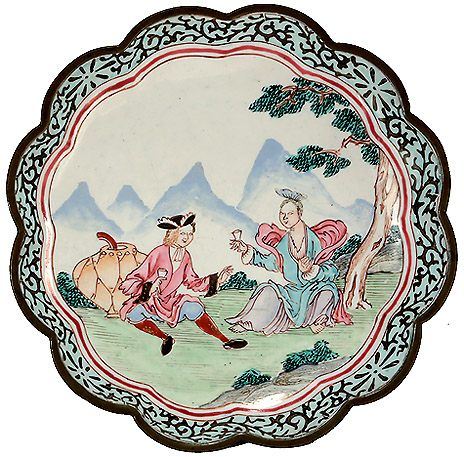
"APÉRITIFS"
"Anticipation" and "Preparation" are at the heart of the "Advent Season" -
looking forward to the wondrous coming celebrations and events ...
whilst reflecting a bit upon events of the past.
The Advent Season begins in Western churches the 4th Sunday before Christmas,
ending on Christmas Eve.
So as Advent prepares the heart,
thus does the "Apéritif" prepare the expectant palette for the marvelous meal to come!
Derived from the Latin word
"aperire"(to open),
history records the aperitif in use since the 5th century -
however, gaining European popularity not until the 19th century -
and the Americas by 1900 .
This "preparatory category" includes alcoholic beverages that are
usually dry - rather than sweet :
with such favorites as vermouth (introduced in Turin Italy 1796),
Dubonnet (introduced in France 1896),
champagne, gin, dry sherry, and still, dry, light white wine.
May we suggest a few – along with their vessels (definitely of the past) !
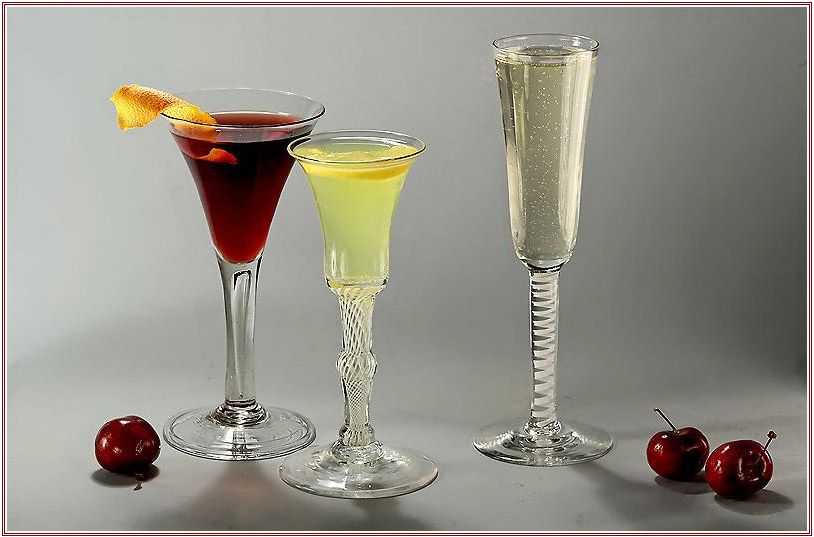
Left :
c1750 English Drawn Trumpet with Teared Stem & Folded Foot,
containing the
"first" French
aperitif,
Dubonnet Rouge, a blend of herbs, spices and peels,
introduced to make quinine more palatable for French soldiers then fighting malaria.
This particular
version is mixed as two parts
Dubonnet
to one part gin,
the mixture, with a slice of lemon, reportedly the favorite drink of Queen Elizabeth II.
Middle :
c1750 Enamel Twist
Wine with Folded Foot,
with the delightful
Sparkling Limoncello Cocktail
(1 shot Limoncello, 2 shot sparkling Sanpellegrino lemon soda & 3.3 fl oz. Prosecco)
Right :
George III Enamel Twist Ratafia Flute, England, c1760
Serving equally well
for champagne or Prosecco (the
Italian "champagne")
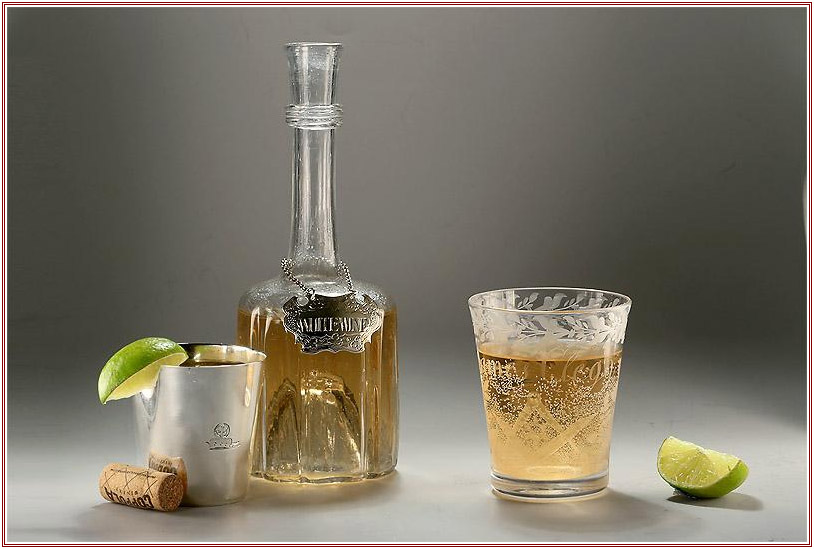
Left : George III Silver Beaker, Aaron Lestourgen, London, 1774
Crested for Willliam Comber Kirkby or his son William Kirkby,
with the traditional favorite, Gin & Tonic – with lime.
Middle : George II Cruciform Decanter, England, c1740
A very early clear glass decanter with another traditional favorite,
White Wine - as indicated by the encircling
George II Silver Escutcheon Bottle Ticket, William Cripps, London, 1743-50
Right : George III Engraved Masonic Beaker Glass, England, c1790
the Masonic compass & square centering a radiant sun with foliate sprays
& the name "James Clegg",
serving a drink for those who desire the "lighter side" :
A Classic White Wine Spritzer
(Equal parts of Sauvignon Blanc and sparkling water (5 oz.), and .5 oz. Torani Mango Syrup)
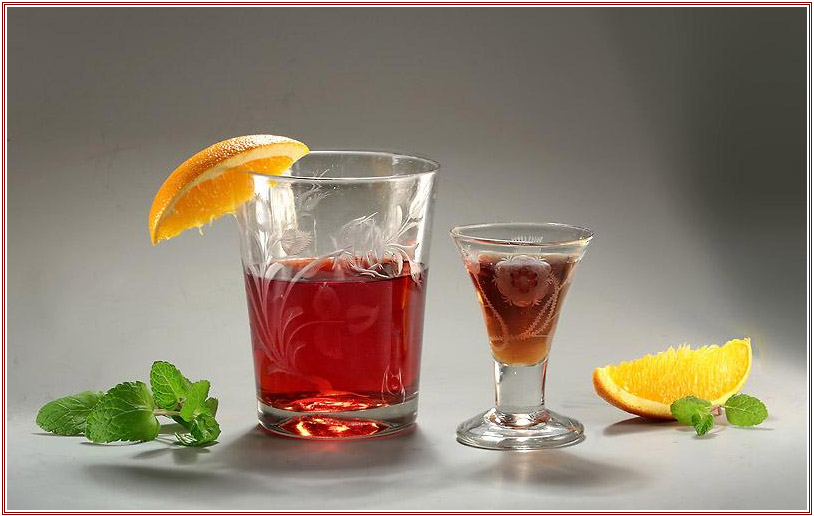
Two Rare Jacobite Glasses :
Right : Engraved Jacobite Dram Glass, with Stuart Rose, Two Buds & Thistle,
mid-18th century, with another traditional aperitif - Sherry
&
Left : Rare George III Jacobite Glass Beaker, England, c1765-75
Engraved with 2 roses, each issuing two rosebuds, the reverse with three bees
serving an Negroni Cocktail born in Florence Italy -
a drink recommended only before a hearty meal,
as its combination and strength "would have sunk Henry VIII"! -
but perhaps not so Charles Edward Stuart...?
(1 ounce Campari, 1 ounce gin, & 1 ounce sweet or semi-sweet red vermouth)
... And speaking of “light’...
"APÉRITIFS" also include "LIGHT HORS D'OEUVRES".
So may we suggest :
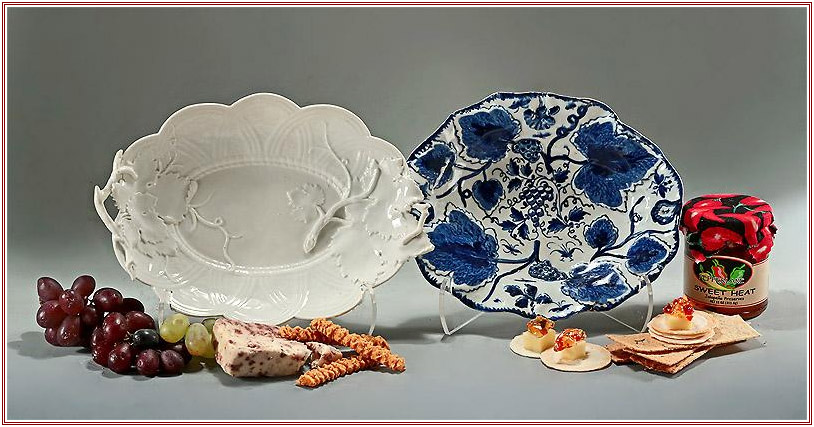
A mixture of seedless Muscato Grapes & White Cheddar Cheese, served appropriately in a
Bow Porcelain Blue & White Lobed & Moulded Leaf Dish with Fruiting Grape Decoration,
England, c1765-70 (right)
&
An assortment of Murray’s cheeses, crackers and sweet spicy jams (chili-fig, and jalapeno)
served upon a
Scarce Chelsea
Porcelain White Leaf & Basket Molded Stand, England, c1752-54 (left)
(Incidentally, the form of this stand is so favored that it was
copied for Pier One a few years back).
And of course, if from
anywhere in the Mid-South,
a selection of hors d'oeurvres is terribly incomplete without Memphis' own
"AUNT LIZZIE'S CHEESE STRAWS"!
"CORDIALS"
It might be said that cordials are actually a lot like "Christmas" itself –
a sweet, rich culmination,
of the year, the season, the friends, generosities, anticipations and aspirations
and maybe – of the heart!
Ah, Christmas.... how wonderful it all is!
And oh to savor the moments just a bit longer...!
So the after-dinner "Cordial"
- like a good Shakespeare denouement -
offers the gracious unrushed closure to our celebrative meals.
In Middle English, the word "cordial" actually meant "of the heart",
from the Latin "cor" (heart).
It is further defined by Webster as
"showing or marked by warm and often hearty friendliness, favor, or approval" –
(just as does the "Cordial").
However, unlike the "apéritif"
...and a bit like Christmas...
"cordials" are sweet and rich alcoholic beverages,
often in a base of whiskey, rum or cognac,
with lingering flavorings as herbs, fruits, chocolate, and coffee.
The 18th century "cordial glass" often has a quite small bowl (about 2 oz.),
raised on a long sturdy stem.
These are wonderful to see - and to handle.
However, the shape's purpose encourages slowly savoring the rich drink -
along with the moments of reflection - and friendship.
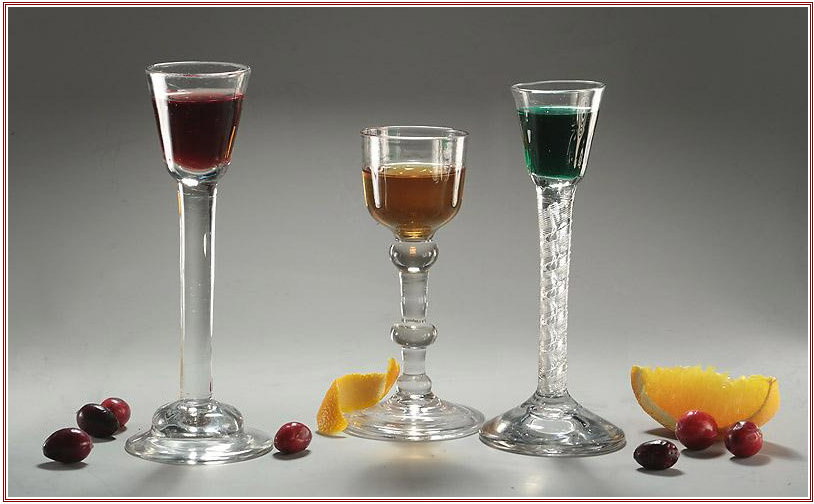
Left : George II Irish Cordial Glass, with Domed Foot, c1740
with Chambord, a drink inspired by a Loire valley raspberry liquor made in the 1600s -
and greatly favored by Louis XIV.
Middle : Early George II Balustroid Cordial Glass with Folded Foot, England, c1730
with the ever-favorite orange flavored Cognac brandy, Grand Marnier.
Right : A George II Airtwist Cordial Glass, c1750-60, with Central Flattened “Mercury” Thread,
with peppermint flavored Crème de Menthe
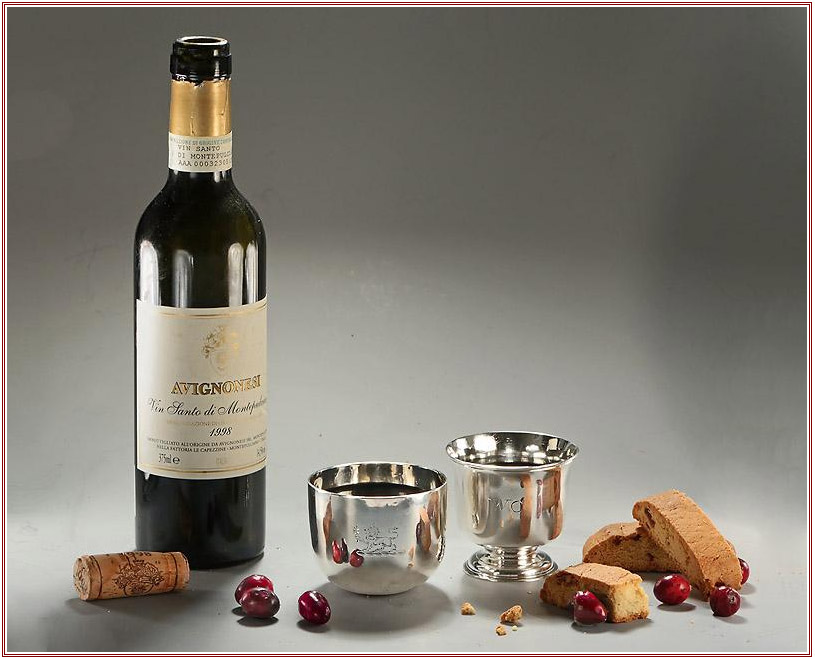
Should you be so fortunate as to have
a good vintage Tuscan Vin Santo,
perhaps you would find silver a more appropriate vessel.
I am told some Vin Santo – a thick dessert wine that is often very sweet and rich –
is sold with a single spoon for serving -I pray that is silver as well!
Another name for Vin Santo (Vinsanto) is "Holy Wine",
the sweet rich wine in favor with Italian Renaissance clergy for communion.
Vin Santo is also recommended for dipping with biscotti.
Right : George III Silver Tumbler, Samuel Strathan, London, 1807,
crested for the family of Turner
&
Left : Early George II Silver Tot Cup, George Greenhill Jones, 1731, London,
initialed to the front WC
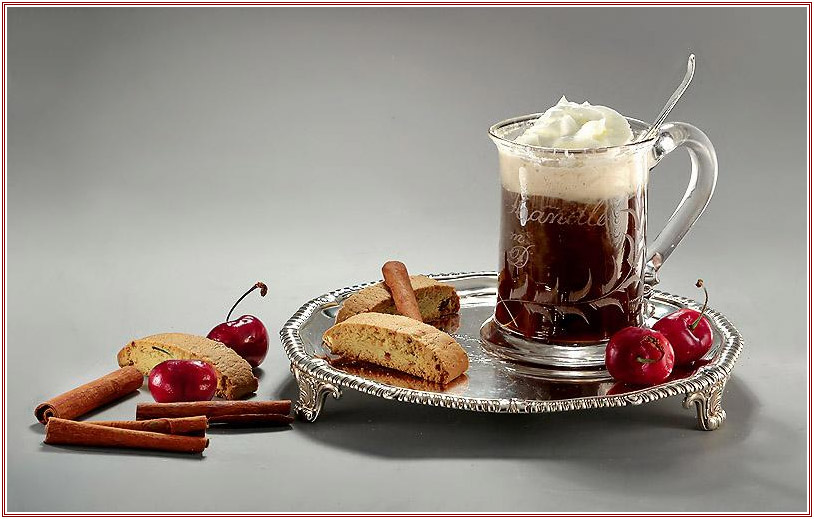
Late George III Engraved Lady's Glass Tankard, England, c1800-1820
Engraved to the front 'Ethel Randle from A.D'
filled with 2 parts hot coffee, 1 part Kahlúa, and fresh whipping cream;
atop a
George IV Armorial Silver Salver, William Stroud, London, 1821,
arms & motto of Granville Leveson-Gower, the 1st Earl Granville
Provenance : How of Edinburgh
Another form of “cordial” – quite apart from the beverage –
is the "Chocolate Cordial" –
a fruit placed within a chocolate shell and then aged until the sucrose liquefies.
Perhaps the most beloved of all cordials is the foil wrapped
"CHERRY CORDIAL",
a Christmas tradition :
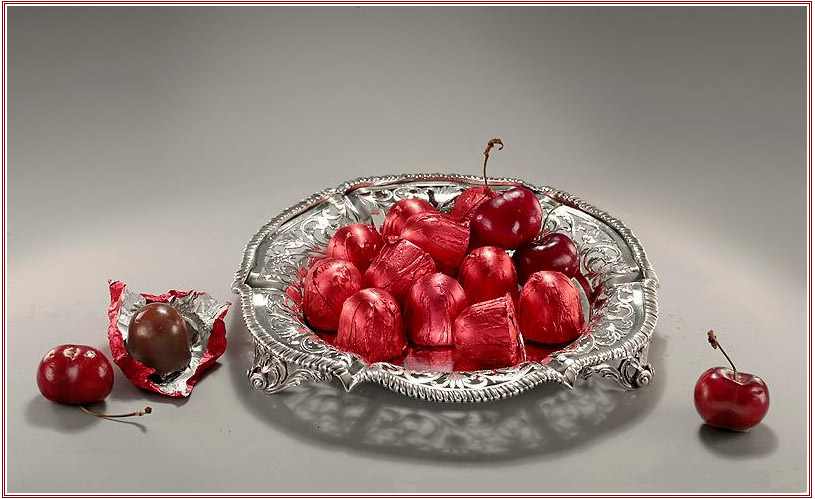
Upon A
George IV Silver Waiter or Stand with undulating pierced border,
Charles Price, London, 1827
And, both first - and last - is this delightful mid-18th century depiction of
a European couple seated on a hillside, glasses in hand,
and enjoying possibly an aperitif (or cordial)
accompanying their festive meal ...
... maybe even at the Holiday season,
so imbued with wondrous indulgences of food and drink,
and a "sweet" nostalgia of oft long-forgotten wares and customs.
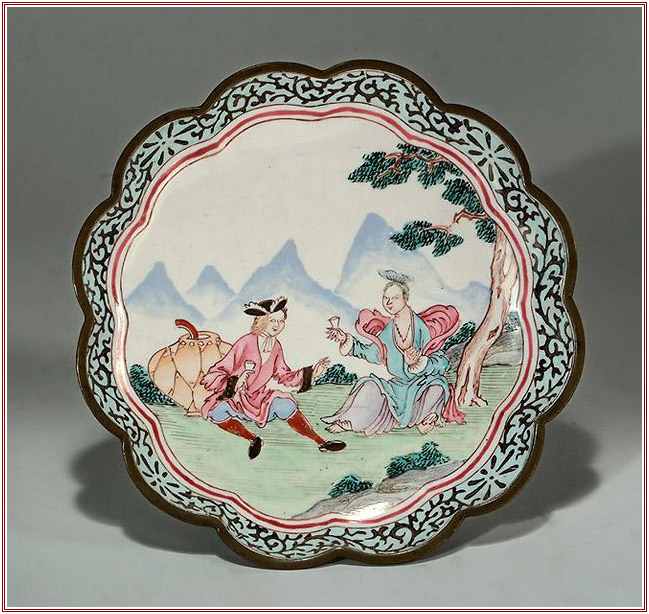
Chinese Canton Enamel Small Fluted Dish with a European Scene,
Qianlong, mid-18th century
SALUD!
May, too, your Holiday Season be filled with a richness of "indulgence" –
as well as a bit of treasured nostalgia and elegance – of yesteryear !
Millicent Creech
Anna Bearman
Camille Fleischauer
Please click on the images and titles above for the detailed pages.
And do call or email should you wish additional information or prices.
Our Additional "Christmas Catalogs" :
MAY YOUR "JUST DESERTS" be only ..."JUST DESSERTS" :
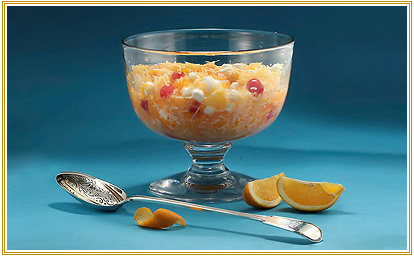
THE "EXTRAORDINARY" GIFT :
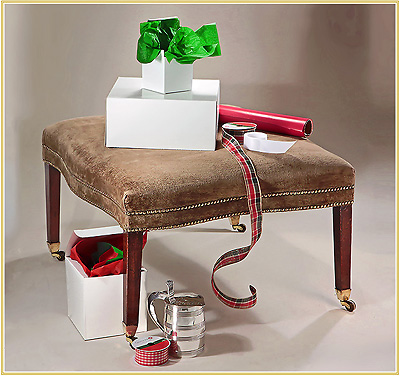
|